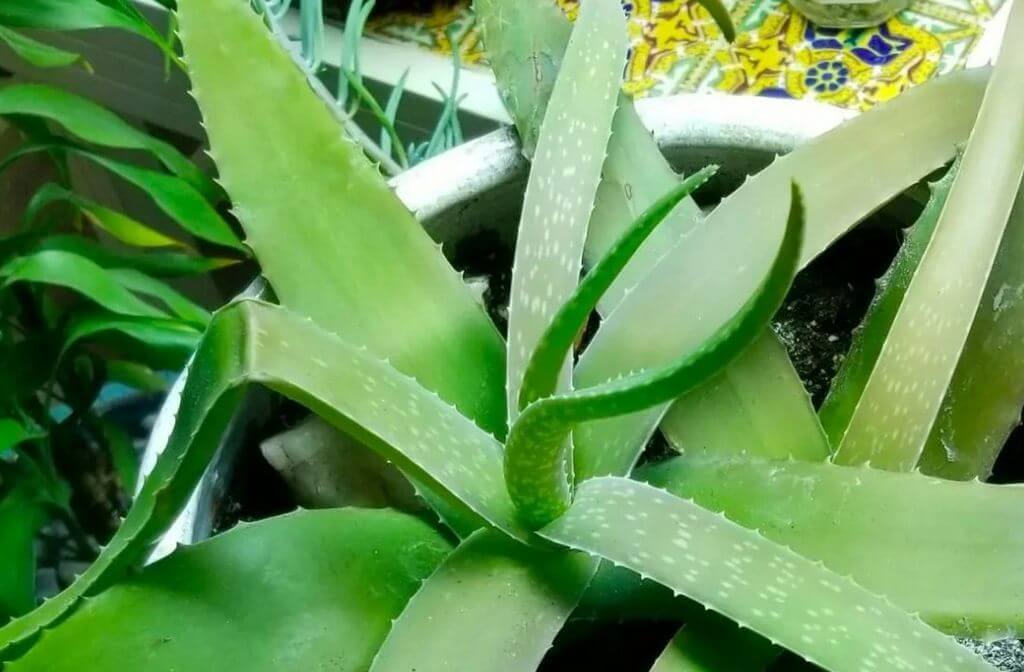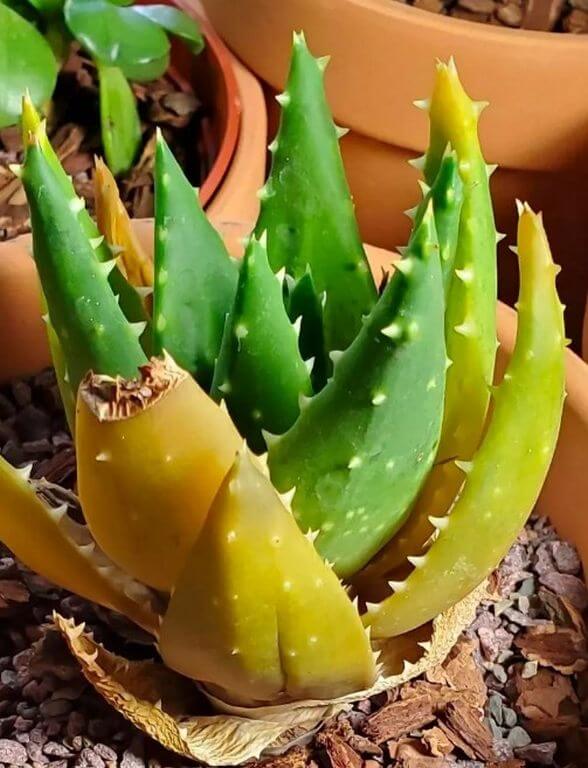Droopy Succulent – Succulents store water in their leaves and stems. This lets the plants thrive in dry places. But even hardy succulent plants can start to wilt.
A drooping succulent shows something is wrong. But you can bring it back to health. This guide explains why succulents droop and how to fix them.
Key Takeaways to Revive a Droopy Succulent
| Problem | Solution |
|---|---|
| Not Enough Water | Succulents need less water than other plants. But too little water makes them go limp. Check if the soil is bone dry. Water thoroughly until water drains from the bottom. Then let the soil dry again before the next drink. |
| Too Much Water | Too much water rots the roots. Check for black, mushy roots. Repot in dry soil if needed. Water less from now on. Let the soil dry between waterings. |
| Not Enough Sun | Succulents want lots of sun. At least four hours a day. Less light makes them stretch and go limp. Move it to a brighter spot if possible. A grow light also works. |
| Pests | Bugs like mealybugs drain succulents of nutrients. Check under leaves for white fuzzy bugs or webs. Wipe them away with alcohol. Spray insecticide if needed. |
| Cold Temperatures | Succulents dislike cold below 45°F. Frost damage turns leaves brown or black. Move indoor succulents away from cold windows. Outdoor succulents need winter protection. |

What Does a Droopy Succulent Look Like?
It’s normal for some succulent varieties to have downward-pointing leaves. But if you notice significant changes in the orientation and appearance of the leaves, it likely indicates a problem.
Here are the most common signs of a droopy succulent:
Leaves point down instead of up
Soft, wrinkled, deflated leaves
Thin, stretched-out stems
Lack of new growth
Yellow or brown leaves
If your succulent shows these symptoms, it needs your attention. The sooner you can diagnose and address the underlying issue, the better chance your succulent has of bouncing back.
If you have others problem such as :
You can learn how to fix the problem by reading that articles.
Why Is My Succulent Drooping?
Many factors can cause succulent leaves to start drooping. Here are the most common reasons for a droopy succulent plant and how to identify them:
Overwatering
Too much moisture is the number-one reason succulents fail to thrive. Their fleshy leaves and stems are adapted to store water. But constant wet soil leads to root rot and the inability to absorb nutrients.
Signs of overwatering:
Soft, mushy, transparent leaves
Brown or black spots on leaves
Leaves fall off easily
Foul odor from the soil
Underwatering
While overwatering is more common, a severely dehydrated succulent will start to droop. Without enough moisture, the leaves will shrivel and deflate.
Signs of underwatering:
Wrinkled, deflated leaves
Dry, brittle leaves
Dull, faded color
The soil is bone-dry
Insufficient Sunlight
Succulents thrive in bright light and need at least 4-6 hours of direct sun daily. Without enough light, they start to stretch out and go dormant.
Signs of insufficient sunlight:
Leggy, stretched-out growth
Lack of stress colors like red tips or blushing
A few new leaves or flowers
Pest Infestations
Common succulent pests like mealybugs, aphids, and spider mites can weaken and deform new growth. Severe infestations sap nutrients and moisture from the leaves.
Signs of pests:
White cottony buildup or webbing
Small insects crawling on leaves
Sticky residue on leaves
Distorted or damaged leaves
Cold Damage
If temperatures dip below freezing, a succulent can sustain cold damage. The water in the cells freezes and expands, rupturing the cell walls. This leads to black, mushy leaves and spots.
Signs of cold damage:
Black or brown damaged areas on leaves
Leaves turn to mush
Damaged, rotting roots
Discolored, droopy leaves
Now that you know what causes succulent leaves to droop, let’s go over how to fix the problem and revive your plant.
Step-By-Step Guide to Revive a Droopy Succulent
Follow this simple step-by-step process to nurse your succulent back to full health:
1. Remove the Soil and Assess Roots
Carefully remove the succulent from its pot. Gently loosen and remove as much soil as possible to inspect the roots.
Look for black, brown, or mushy roots, which indicate rot. Healthy roots should be firm and white.
2. Trim Off Dead Roots and Leaves
Use sterilized scissors or pruners to trim away any dead, damaged, or rotting roots. Also, remove any dead or dying leaves. This prevents decay from spreading.
3. Repot in Fresh Soil
Repot your succulent in a new container with fresh, well-draining soil. For most varieties, a cactus mix amended with perlite or pumice works well.
Make sure the pot has drainage holes at the bottom.
4. Find a Warm, Sunny Spot
Place your succulent in a warm location with plenty of bright, indirect sunlight. Southern or western-facing windowsills are ideal.
Avoid the direct, hot midday sun, which can scorch the leaves.
5. Hold Off on Watering
Don’t water the succulent right away. Wait until the soil has fully dried out before watering again. This prevents excess moisture from worsening root rot.
6. Resume Normal Care
Once any rot has been removed, the roots have been trimmed, and the soil has dried out, you can resume your normal care routine.
Make sure to:
Water only when the soil is completely dry
Provide bright light from an east- or west-facing window
Use well-draining soil
Pour out excess water from the drainage tray after watering
With time and proper care, your succulent will show signs of new growth. The leaves will firm up, regain their color, and point upwards again.
Frequently Asked Questions About Droopy Succulents
Here are answers to some common questions about caring for a droopy succulent plant:
How long does it take for a succulent to recover from drooping?
With proper care, most succulents show signs of improvement within 1-2 weeks. But full recovery can take 4-6 weeks. Be patient and maintain ideal growing conditions during the rehab process.
Should I cut off the healthy parts of a droopy succulent?
No, only remove dead, dying, or damaged parts of the plant. Cutting into healthy tissue can just add stress. Leave any firm, intact leaves to photosynthesize and fuel new growth.
What is the ideal temperature for a droopy succulent?
Succulents prefer daytime temperatures of 70–80°F (21-27°C) and around 60°F (15°C) at night. Avoid cold drafts below 50°F (10°C), which can damage plants.
How can I increase humidity for my succulent?
Use a pebble tray, mist occasionally, or place a small humidifier nearby. Just don’t overdo it. Too much moisture encourages rotting. 40–50% humidity is ideal.
Should I fertilize a stressed, droopy succulent?
No, hold off on fertilizer until your succulent recovers. Fertilizing a stressed plant can do more harm than good. Wait until you see signs of new growth before adding diluted fertilizer.
Final Thoughts
It’s normal for succulent leaves to occasionally droop or wrinkle slightly when they need water. But significant changes in orientation or texture indicate a problem. With this guide, you now know how to assess the cause and take action to revive your succulent.
The key is paying close attention to your plant’s care routine and environmental conditions. Succulents are adaptable but need the right balance of sunlight, temperature, soil, and moisture.
With a little time and TLC, you’ll start to see your succulent perk up again. Just remember to have patience during the recovery process. Consistent care will help nurse your plant back to full health.

